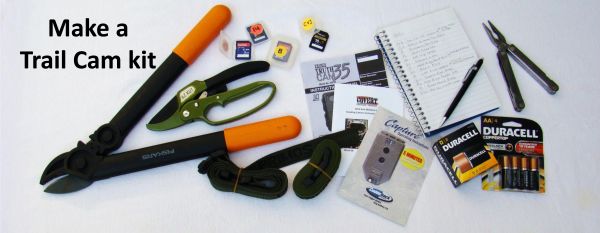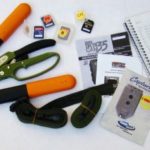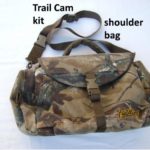
Put together a trail cam kit
As we transition through the humid and hot doldrums of mid-summer, it is time to begin preparing for the upcoming trail camera season.
Deer season will be here before we know it and there are so many things that can be done ahead of time to maximize your odds for success over the fall and winter. Let’s look at one particular task that can be performed right in the comfort of your own home.
This putting together a “trail cam kit” or shoulder bag that will contain several pieces of essential gear for setting up and checking your trail cams. When running a string of cameras from the preseason on through hunting season, it is important for a serious trail camera user to be as efficient as possible to minimize your time at each camera site and eliminate extra back-and-forth trips for things needed but not brought along.
I use a large camo-pattern shoulder bag that has several compartments and pouches. Here is a list of some of the main items that I carry with me and why they are necessary:
Nitrile surgical gloves — These are used to keep human scent to a minimum when handling and setting up trail cameras.
Duplicate memory cards — It is much easier and less intrusive to have duplicate cards for swapping out rather than having to remove a camera or leave it cardless.
Extra camera batteries — Always carry along more fresh replacement batteries than you think that you might need. Nothing is worse than having to leave a camera out with weak batteries for a week or so because you forgot to bring extra batteries along, only to find the batteries died after just two days.
Lobbing or pruning shears — Having a compact set of lobbing or pruning shears, and maybe even a small handsaw, can be a real asset for removing grass, brush and tree limbs that would otherwise obstruct your cameras view or trigger your camera if blown by the wind.
Leatherman tool or equivalent — This is a very compact way to be prepared for an emergency camera or camera stand repair. It will not be often needed, but in my years of experience with remote camera sites, an ounce of prevention is truly worth 10 pounds of cure.
Small notebook with a pen or pencil — This item can be used to record observations as you move between camera locations and also as a reminder of just where each camera is located when you next run your cameras.
One prime example would be to record something like, “Camera P-3 has 40 precent remaining battery life. Change batteries next trip.”
Since I typically run anywhere from 12 to 15 cameras during deer season, it is sometimes hard for me to remember that I changed a camera location from one week to the next. I keep a running list of cameras and their locations, and make notations when any of them are moved and where they are moved to.
An up-to-date location list is also very helpful after changing out camera cards when you are back at home sitting at your computer and saving the latest batch of images into file storage.
Operating instruction pamphlets — I run several brands and models of trail cameras simultaneously, so if something unexpected happens, having the instruction pamphlets in your bag can sometimes be a real life-saver.
I do not suggest that my list of camera bag items is exactly right for everyone. You might find the need for additional items or that you can eliminate some of my suggestions and still get the job done.
The main thing is to enjoy using cameras and to obtain from their use actionable information that makes your time in the field as productive as possible.
One additional item that was not listed above that I have found at times to be invaluable is an iPad with an attached adaptor cable and memory card reader.
Now, granted, carrying an iPad around in the field and protecting it from damage can be somewhat cumbersome, and, yes, there are handheld trail cam card reader devices on the market. But, in my humble opinion, during the core portion of the whitetail prerut and rut, any additional bother is way more than offset by the ability to get instantaneous buck movement data right at the camera site.
If you have an iPad, use it if you can. The much larger and higher-definition screen, larger available memory and faster processing speed can be a real advantage when operating on-the-fly out in the field and quickly scanning through potentially hundreds of photos.
As a direct result of having my iPad along, I have wound up leaving cameras in place that I had had every intention of moving, and I have moved cameras to more promising locations when a quick iPad memory card review revealed that nothing had been going on at a particular site.
The relatively short time frame of the whitetail rut makes every hour of every day that you can be afield extremely precious, and I do not want to waste any more of that precious time than I absolutely have to so fruitless “goose chases” can be avoided.
If you are not already using a trail cam kit, consider putting one together. If you are using one, review the items in your current kit to see if you are leaving out anything that might be essential or handy.
Remember the old adage that luck has a habit of occurring when preparation meets opportunity.




